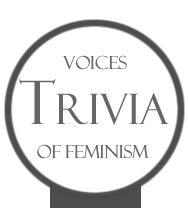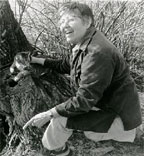On Living with a Poem for 20 Years: Judy Grahn's "A Woman Is Talking to Death"
Elliott Femynye batTzedek
Poetry is what someone makes when she desires to hear a certain language and cannot already hear it in the world
Amitai F. Avi-ram1
What's pushing the grammar and syntax, the sounds, the images—is it the constriction of literalism, fundamentalism, professionalism—a stunted language? Or is it the great muscle of metaphor, drawing strength from resemblance in difference? The great muscle of the unconstricted throat?
Adrienne Rich2
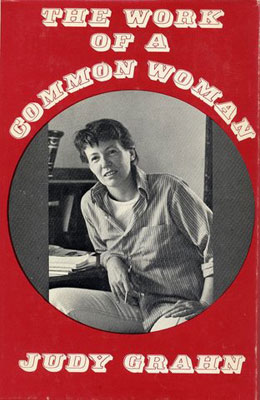 What does it mean to live with a poem for twenty years?
What does it mean to live with a poem for twenty years?
But that's a rhetorical question, and rhetorical questions are so afraid of their own convictions. Inadequate, when this poem and its life with me are so very real.
From the top, then.
This is what it means to live with a poem for 20 years. When the news exploded across my office that planes had hit the towers in New York, I rushed to the web to see it for myself, to know if it was a fact even though I wasn't there. The first sentence to cohere in my mind was this: all the chickens come home to roost/all of them. Meaning not the folk saying, common enough in my childhood with its actual chickens and actual roosts, but that maybe the hijackers, terrorists as they would so soon come to be called, maybe they were Josie's babies. Not the babies of any Josie I've ever known, but of a girl Judy Grahn knew, so many years ago, a brown-skinned girl, pregnant at 13.
Josie came into my life in section four of Grahn's transcendent elegy "A Woman is Talking to Death." Grahn describes loving Josie, and wanting to kiss her, because she saw the pain and fear in her eyes. But thirteen herself, in a hostile place, she did not kiss her, and later includes her lack of courage and inability to protect Josie as parts of a litany of indecent acts she regrets bitterly. In the poem's sixth section, Grahn tells the story of a young man who called her names in Spanish and slugged her, in front of people who seemed satisfied that a queer had been hurt. Recalling this attack, weaving it into this poem that explores the connections and consequences in our lives, she writes:
now when I remember I think:
maybe he was Josie's baby.
all the chickens come home to roost,
all of them.
That unreal morning, even as I knew the violence happening was exactly our violence, coming home to roost high above the tops of the tallest trees, I also knew in my gut that these men might be Josie's babies, and image after image from Grahn's poem lived through the next days with me, comfort and warning.
This is what it means to live deeply with a poem for twenty years, to have encountered it in so many different parts of your life that its presence is thread through a needle, and everything you do is stitched with it. At the moment that a poet's words become the best words to describe your own reality, the poem becomes sinew, stretching from the poet to you, across time and distance and culture. The Psalms function this way for many people, Shakespeare for others, or Rumi. Or, if you were an 11 year old in 1974, an aspiring poet whose access to books was limited to the B. Dalton at the region's only mall, Rod McKuen. Hallmark tries to function this way, noble aspiration gone to $2.49 seed.
To live in such a long-lasting (albeit non-monogamous) relationship with a poem is to recall it lingers with you like remembered first kisses and friends who stayed when all the world pulled away. I can see and smell the apartment I was visiting when I first read this poem, still recall the urgent, groggy feeling when I finished it, stunned, with no idea how much time had passed, nor what had happened around me while I read. As Adrienne Rich writes of her first experience with Grahn's poem, "I knew in an exhausted kind of way that what had happened to me was irreversible. All I could do with it at that point was lie down and sleep, let… the knowledge that was accumulating in my life, the poem I had just read, go on circulating in my bloodstream." I've read this poem hundreds of times in the years since, to myself, out loud in large and small groups, and every Yom Kippur, as a liturgy of failure and redemption that speaks to the very center of my life. "A Woman is Talking to Death" explains a way that I understand the world, and so appears everywhere in my own work – its pacing, humor, unexpected moments of rhyme and meter, the way its pattern of repetition and variation relentlessly propels the narrative to its closing moment of triumph: "death, ho death/you shall be poor."
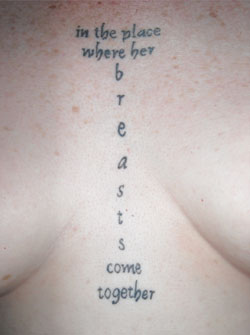
in the place where |
My own love affair with poetry solidified with Grahn, because poetry finally mattered, urgently. I was 24, two years past finishing BAs in English and Creative Writing that focused on, yes, poetry. In school, I knew I was supposed to like certain poets, and supposed to like counting iambs and mapping rhyme patterns. Supposed to prefer strong masculine rhymes to the feminine rhymes forced to dwell in doggerel and limericks, this latter message reinforced by the inclusion of only three women writers in the official curriculum: Woolf, Plath, and Sexton, all offered as interesting second-tier writers, and all with the strong suggestion that something about being a successful but uterus-endowed writer caused a suicidal bent. To be honest, some of the resulting dislike of poesy was my resistance as a matter of course to what experts thought—chalk it up to my working class background, or a solid and stubborn Midwesternism in the face of four years of East Coast snobbery, or a well-rehearsed defensive position as a tough little tomboy grown up. As a constant outsider because of my class, my native dialect, my sex and my gender, I clung stubbornly to Walt Whitman, the one poet whose words seemed to speak to me, and whose opinion of the learned astronomer—that walking quietly under the stars would teach more about them than the lectured list of numbers— rang true with me for some several of my learn'd English teachers. Following Walt, I often left the lectures with their charts and graphs and went outside to look around me for a different kind of knowledge.
Whitman's stresses, beats, repetition, his command of verbs, his always present alliteration and patterns, represented Poetry to me. Small wonder, then, that my first encounter with "A Woman is Talking to Death" changed me as a writer. I was a young, eager sponge of a lesbian separatist, so the poem would have left a deep impression on me as a reader solely for the truth it tells. But, feeling Whitman so deeply, I also felt Grahn's power as a writer, as a force of both content and construction. I knew that Grahn had been a founder of the world of lesbian culture in which I came out and came of age, that women lined up to hear her read and felt changed by her, that they bought her record, and played it over and over, weeping because someone was finally saying The Truth. I knew she'd founded the first press to do "women's" poetry, meaning lesbian and feminist words. She was A Founding Amazon/Mother; my first copy of The Work of a Common Woman a courting gift from my first woman lover, and I've given a copy to every lover since who didn't have her own.
But I also knew something else, that I couldn't quite give words to at the time. I knew Grahn sounded familiar, like my people, working-class people, and that she was nonetheless a brilliant writer. Nothing in my outer world, or my academic world, would have confirmed that, though, for Grahn and so many others of her peers were dismissed as "political writers." Even Adrienne Rich, as her work became so explicitly feminist, was presented to me as a great poet who had let her politics overwhelm her poetry. Since I knew her poem "Rape" was the only true thing I read my entire senior year of college, I was already backgrounding the dismissive voice, but still it lingered. As Alicia Ostriker says of her own work and of Grahn, "one of the major claims made about political poetry in general and identity-oriented poetry in particular is always that it's not truly poetic."3
Yet I knew Whitman was taken seriously, and I knew how his voice, music, and project shone through "A Woman is Talking to Death." Knowing how carefully and lovingly Whitman catalogued the residents of his nation, I immediately understood Grahn's project, although, a bitter century later, Grahn gives us the stories of how democracy and equality have failed for so many rather than Whitman's glorious assertion that all would be included. Both of these writers I love have constructed a sense of "all" as a communal experience created not by asserting some single, universal truth but by finding commonality in differences. And both are major U.S. poets, with one major difference—a literary world that takes the gay male writer very seriously, while dismissing the lesbian writer as "political," a shining example of the politics of poetics4.
that same week I looked into the mirror
and nobody was there to testify
how clear, an unemployed queer woman
makes no witness at all,
nobody at all was there for
those two questions: what does
she do, and who is she married to?
from One: Testimony in trials that never got heard
If this dismissal, the erasure of so much of the genius of the second-wave lesbian feminists, means that you don't know "A Woman is Talking to Death," or that you've not thought about it in years, you need to know it. It is gifted writing and urgent truth-telling, still relevant in world where power has changed little in three and a half decades. "A Woman Talking to Death" is a triumphant elegy, a nine-part poem that mixes fact and fantasy, narrative and modern myth-making. Written in the early 1970's about events in the 50's and 60's, it reflects a time of tremendous oppression, based in large part on Grahn's own expulsion from the military for being lesbian. The poem tells a series of inter-related stories that memorialize the lost, drowned, and dispossessed of her generation; while mourning these losses, the poem also creates and celebrates a community of resistance. This community, imagined as "lovers," challenges the social powers cast in the poem as Death or as agents of death.
In the tradition of Whitman and Ginzberg, chroniclers of their generations, Grahn writes in a free verse rich with physical details. Her lines vary widely in length and pace as her poem switches from narrative to fantasy, with some sections in near prose. And also, as with her poetic predecessors, her "free" verse is driven and deepened by careful use of poetic structures: beats, stresses, meter, rhyme, alliteration. When relating stories distinguished in the poem as fact to which Grahn herself paid witness, she writes in long, flowing lines describing settings, actions, and characters. Once the details are known her writing shifts; words are pressed through finer and finer sieves, strained down to what is most vital. At these still points, she often switches to meter or clear beats, or begins to incorporate rhyme or alliterative-driven stresses. Within this pulsing rhythm, patterns of repetition and variation of language and image run through the poem, weaving together personal and social stories across time and culture.
The poem begins with a ritual incantation Grahn repeats and echoes throughout:
my lovers teeth are white geese flying above me
my lovers muscles are rope ladders under my hands
Grahn often uses ritual or liturgical elements in her writing5; lines and verses with the feel of chants and hymns often appear in her poems, although always based in a new, original mythology, for Grahn is consciously inventing a new social order. These lines of incantation are here only as an opening chord, for the poem moves immediately into its central story, a night on the Golden Gate bridge when Grahn witnessed a young white man on a motorcycle accidentally hit and killed by an Black man. This is the longest story in the poem, told in precise images and a free verse that is nearly prose:
Then we heard the meaning of the noise
of metal on a concrete bridge at 50
miles an hour, and the far left lane
filled up with a big car that had a
motorcycle jammed on its front bumper, like
the whole thing would explode, the friction
sparks shot up bright orange for many feet
into the air, and the racket still sets
my teeth on edge.
Grahn's marginal social identity as queer, unemployed and unmarried marks her as un-person, unable to bear witness. She leaves the Black driver alone to face the police who will beat and arrest him, bring false charges, and convict him with a sentence of twenty years to life. In between verses of long lines recounting this story, Grahn switches to sparse, rich language, using iambic pulses of three or four beats that mark and measure the emotional realities behind the facts. After refusing to stay, Grahn sums up the narrative to this point with these lines of four and three pulses:
I am the woman who stopped on the bridge and this is the man who was there
A few lines later, after the story of his arrest, she introduces the poem's struggle with Death in these lines of three and then four pulses:
a woman is talking to death,
though talk is cheap, and life takes a long time
Grahn uses these pulses every time the poem moves from narrative to the heart of the matter. The pulse lines function as lodestones, giving direction and carrying the load of the poem's entire meaning:
…"My God, and now I've killed somebody."
…but we ourselves are easily squished
…He died laughing: that's a fact
…this woman is a lesbian, be careful
…we all have our lists of casualties
…have you seen the twinkle in the dead woman's eye?
…to my lovers I bequeath/the rest of my life
…death, ho death/you shall be poor
Grahn plays with traditional meter in all of her work, most clearly illustrated in this poem in "Five: Bless this day oh cat our house." This section is a lyrical interlude, beginning with a story of a child being protected, then calling down blessings to help challenge Death's demand that Grahn not touch another woman. To establish a tone of emotional comfort and familiarity, Grahn uses iambic meter and rhyme; when Death immediately breaks this scene, she breaks down the structure, her lyric flow giving way to violence through subtlety dropping an at and using an in rather than an into:
Bless this day oh cat our house
help me be not such a mouse
death tells the woman to stay home
and then breaks in the window.
All of Judy Grahn's work uses humor and word play, often as a counterpoint to the intensity of the subject matter. She plays with semantics, pulling words from one context in order to challenge perceptions in another. After the long story in "One: Testimony in trials that never got heard" about how a Black man driving home accidentally killed a white man and was subsequently imprisoned for decades, she moves on in section two to contemplate the effect of historic acts of violence against women: raiding in villages by local lords and the European witch trials. With the current and the historic, the racism and the misogyny, in play, she describes the second stories with a word that binds them intimately with the first: "they don't have to lynch the women/very often anymore." Section "Four: A Mock Interrogation" builds to the powerful flash of its ending through Grahn's intentional reversal of the language used to accuse her. Asked if she has held hands with a woman, she cites a long paragraph of women in distress she has comforted or embraced. Asked about the first woman she kissed with serious feeling, she tells the story of a pregnant classmate named Josie before admitting she did not in fact kiss her; to the attempted degradation of the final challenge "Have you ever committed any indecent acts with women?" she produces a litany of her guilt, woman after woman she failed to help for her own lack of courage, ending, "Yes I have committed acts of indecency with women and most of them were acts of omission. I regret them bitterly."
Grahn uses ambiguity of meaning and symbol to recreate and signal the web of power woven around the dispossessed that are her subject. Two sections of the poem are labeled "a mock interrogation," and both are "mock" in that they are imagined, fake, not real, and that they are stories of those with power mocking those without: in section four a military tribunal humiliates Grahn for being lesbian; in section eight a disembodied legal voice blames a victim of rape for putting herself into danger by getting into a cab. The poem's repeated incantation lines leave out apostrophes and so leave open the number of people for whom she uses the name "my lovers," which in the poem comes to mean both individual women she has loved and all of those whose lives are bound together by oppression or resistance. Of course the title itself, "A Woman is Talking to Death," is the ambiguity central to the poem, invoking in the same breath and location a woman, powerless, talking herself to death, and a woman, powerful, talking to Death, challenging, ultimately staring him down. The poem and Grahn demand that we learn to live in this ambiguity, not in the deconstructionist sense of language having no ultimate, fixed meaning, but as a stance of social dissidence that intends to disrupt how those in power use language.
To uncover and mark connections between people seemingly alien to each other, and so triumph over the powers of repression, Grahn repeats and echoes words, lines, and images, building meaning upon meaning. Death is the main recurring image of the poem, often expressed as drowning, beginning with its physical reality in the first section, and then becoming a symbol for everything that terrorizes, diminishes, or represses her assertion of a radical human equality. Opposition to death rests in four conceptual metaphors: laughter as a statement of resistance and being laughed at as a sign of oppression; having a child in you as an expression of being fully alive and connected; the eyes as arbiters of connection, either being vacant or as having a spark of resistance; and "lovers" as a community of resistance.
These metaphors are repeated, refined, ripped apart and stitched together again as the poem progresses, creating the structure, the skeleton, of the poem. And as always with Grahn, the repetitions become a new reality, one connected across culture, race, gender, and time. In the beginning of the poem, Grahn says twice of the young man killed on his motorcycle on the bridge "he died laughing: that's a fact," and then asks of the driver, sentenced to 20 years, "does he have the most vacant of/eyes, will he die laughing?" Of the young man who died, she tells us, "his thin white seminal tubes all strung out behind; no/child left in him" and then refracts this description for the six white policeman, agents of Death, explaining they had "no child left in them." Of the Black motorist she left that night, she says, "So I left—/as I have left so many of my lovers." In "Two: They don't have to lynch the women anymore," Grahn speaks first of "the woman on our block with 6 young children/[who] has the most vacant of eyes," then moves to describe the history of women murdered in Europe, asking, "did they have […] children/in them?" In "Three: This woman is a lesbian, be careful," Grahn recalls her fear in section one of plunging from the bridge to the hard water below, describing the silence that would descend on every room she entered when the military was investigating her for being a lesbian:
[the other women] were afraid, they knew the wind would blow
them over the rail, the cops would come,
the water would run into their lungs.
[…]They were my lovers, those
women, but nobody had taught us to swim.
I drowned, I took 3 or 4 others down
when I signed the confession of what we
had done together.
Two lines later, she recounts the story of WWII soldiers sent in batches to drown in failed amphibian tanks, pulling the accumulated power of three of the conceptual metaphors into five sharp lines:
[…] did they have vacant
eyes, die laughing, or what? what
did they talk about, those men
as the water came in?
was the general their lover?
Having thus verbally woven together the young white man who died, the Black man who accidentally killed him, a single mother with six children, women killed as witches, herself and the women persecuted by the military, and one hundred fifty soldiers drowned by an unbending bureaucracy, Grahn takes these images and reshapes them in "Four: A Mock Interrogation" to focus on a single woman intimate to her, Josie--the woman/girl who came to me so clearly on that September day. All of the anger, shame, helplessness, love, and resistance Grahn has been building in the poem feed into the description of how Josie disappeared from school when they were both thirteen. When she came back for the final day of school, "there was a child in her. Her eyes were as dark as the water under a bridge and no one would talk to her, they laughed and threw things at her. The consequences of Grahn's inability to defend and love Josie haunt the poem, culminating in "Six: Dressed as I am, a young man once called/me names in Spanish" when she is beaten by a young man whom, she knows, could have been Josie's baby. In this section, she goes to the police station after the beating to report the attack, only to find "they were well pleased with my story, pleased/at what had gotten beat out of me, so/I left them laughing, went home fast/and locked my door." She confesses to dreaming of smashing a chair over the young man's head, knowing that in the fantasy of violent revenge she has "no child in me."
The missing child-the missing or stolen possibility of connection-recurs immediately in "Seven: death and disfiguration." Grahn describes coming upon a 55 year old woman who has been raped by a cab driver and left lying in the snow in a bathrobe. Grahn and her friends call for help, and
Six big policemen answered the call
no child in them.
they […] grabbed her like a corpse and heaved her
on their metal stretcher into the van
The older woman asks the younger women to stay with her, but they were drunk and queer "perverts" and afraid. Telling this story of leaving the woman on a cold winter night to those men who were so very much not alive, the poem's language returns to the Black man abandoned on the bridge, and the resulting echo is the elegy's entire liturgy of loss: "we left, as we have left all our lovers/as all lovers leave all lovers/much too soon to get the real loving done."
"Much too soon to get the real loving done"—with this line, Grahn brings the reality created by the pattern of repetition full circle. While the poem has two more sections, the struggle between Death and community has reached its emotional apex here. "Eight: a mock interrogation" is the sparsest section of the poem, and ends with a clear challenge to readers to carry these stories with us and to tell our own stories: "If you don't remember, how do you know it happened to/you?" In "Nine: Hey you death" Grahn switches to direct language, from explicit keening to victory taunt; the whole weight of the poem's challenge to Death resolves in one triumphant transformation of silence into strength:
wherever our meat hangs on our own bones
for our own use
your pot is so empty
death, ho death
you shall be poor
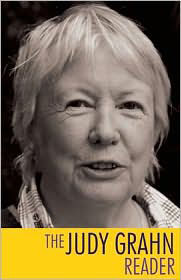 For all these years the full force of what radical re-envisioning could mean has lived in me as this single line. It is my talisman, my shield, my own resistance to violence in this violent, resisting world: death, ho death/you shall be poor. It is wish and want and warning. It shines across a world of brass words, these few polished to glossy by constant use as a prayer for understanding, as a celebration of each day death might go hungry. This is the power of Grahn's writing and what makes "A Woman is Talking To Death" not a political poem but a poetics of politics. To have lived deeply, to go on living deeply, with this poem is to know what it means to dwell in possibility. To dwell with Grahn's words coming out from my own depths is to feel the possibility of a poet to help spread wide my own narrow hands.
For all these years the full force of what radical re-envisioning could mean has lived in me as this single line. It is my talisman, my shield, my own resistance to violence in this violent, resisting world: death, ho death/you shall be poor. It is wish and want and warning. It shines across a world of brass words, these few polished to glossy by constant use as a prayer for understanding, as a celebration of each day death might go hungry. This is the power of Grahn's writing and what makes "A Woman is Talking To Death" not a political poem but a poetics of politics. To have lived deeply, to go on living deeply, with this poem is to know what it means to dwell in possibility. To dwell with Grahn's words coming out from my own depths is to feel the possibility of a poet to help spread wide my own narrow hands.
The Judy Grahn Reader is now available from Aunt Lute Press. It contains work from every phase of Judy Grahn's career, including both poetry from her major collections and new work collected here for the first time. It also represents Grahn's work in other genres, including her groundbreaking essays about language, sexuality, women's spirituality, and menstruation, as well as an excerpt from her experimental eco-feminist novel Mundane's World.
Notes
- "The Politics of Refrain in Judy Grahn's A Woman Is Talking to Death." Women and Language, vol. 10, no. 2, Spring 1987 [return to article]
- Rich, Poetry and Commitment, pages 32-33 [return to article]
- personal communication 14 June 2009 [return to article]
- Why isn't "A Woman is Talking to Death" required reading alongside "Howl" as classics of 20th century poetry and voices of dissent? The answer isn't quality or importance, so I struggle to find any reason other than the measure of misogyny and lesbian hating in this culture. [return to article]
- Judy would become an important voice in the movement for a recovered and newly built women's spiritual theory and practice. Her foundational writing about menstruation as a cultural symbol became her metaformic theory, which takes on history, anthropology and archeology to uncover women's cultural values buried under patriarchal narratives. [return to article]
Working Notes
My lover Mari gave me my first copy of The Work of a Common Woman in Madison, WI, in 1986. I'd never heard of Grahn (I'd not been out that long) and I was stunned. The poems became part of my life, part of the vocabulary I shared with Mari. The next year, when I got her a pet rat (I already had some), she named the little cutey She Who.
I gave a copy of Grahn's book to my partner, Otter, in 1989. She, too, had never read Grahn and was also instantly in love. Years later, when she started a women's/feminist vocal ensemble, they took the name SheWho, and Otter proceeded to do an arrangement of the final poem in Grahn's SheWho series which can still bring tears to my eyes. I spent a lot of time in various used book sources online buying copies of The Work of a Common Woman to give to each new SheWho member. One copy obtained this way is signed "Courtot." Did this once belong to the lesbian poet Martha Courtot? That copy I'm not giving away.
And of course "Plainsong: From a Younger Woman to an Older Woman" has been part of every significant death in my life since I first read it. Every significant love, too, for that matter, for I do truly believe that the bond between women is a circle and we are together within it.
Much more recently, I gave the book to a new love, who didn't get it, didn't get lesbian culture, and didn't particularly see a reason to try. "A Woman Is Talking to Death" is still in my life, but that particular woman pretty much isn't. (She didn't read Dykes to Watch Out For either. Egads.)
When I applied to my MFA program I had to write a 3-4 page paper doing a close reading of a poem. It had been a long time since I'd done critical writing about poetry, and I had such awful memories of having to write about Great Poems that I was unsure, hesitant, lost. So I started writing what became this essay. I dove into this poem, writing about everything I knew and everything I found by searching. 12 pages later – single spaced, too—I surfaced. Hmm, guess I did have a lot to say about how poems work, if I started with work that was urgent to me.
And if you've not read "A Woman is Talking to Death," why are still reading my notes instead of reading the poem itself? You can buy it for just a few dollars from Judy's website. Go, read.
About the Author
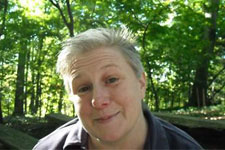 Elliott Femynye batTzedek is a dyke writer who, after 18 years, has come to grips with the fact that she's now from Philadelphia. Her narrative "Wanting a Gun" appeared in Trivia 6 (2007). Her poems, essays, reviews, and cartoons have been published in Sinister Wisdom, Rain and Thunder, Poetica, the online journal Awakened Woman, off our backs, Sojourner, The Lesbian Review of Books and other local and national Feminist journals and newspapers. Her essays have been reprinted in anthologies such as Gender Through the Prism of Difference (Oxford University Press), Lesbian Culture: An Anthology (Crossing Press) and Out of the Class Closet: Lesbians Write About Class (Crossing Press). And even, years ago, in Common Lives, Lesbian Lives and Lesbian Ethics. She is currently working on a MFA in poetry at Drew University. She has worked as an editor and free-lance writer, and currently teaches graduate courses in Children's Literature and Publishing and, after being laid off from a ten-year job, is digging through old boxes of Lesbian Connections issues in search of the circa 1987 crystal collection which came with the promise that the universe was a Great Mother who would take care of us and move all things toward the highest good.
Elliott Femynye batTzedek is a dyke writer who, after 18 years, has come to grips with the fact that she's now from Philadelphia. Her narrative "Wanting a Gun" appeared in Trivia 6 (2007). Her poems, essays, reviews, and cartoons have been published in Sinister Wisdom, Rain and Thunder, Poetica, the online journal Awakened Woman, off our backs, Sojourner, The Lesbian Review of Books and other local and national Feminist journals and newspapers. Her essays have been reprinted in anthologies such as Gender Through the Prism of Difference (Oxford University Press), Lesbian Culture: An Anthology (Crossing Press) and Out of the Class Closet: Lesbians Write About Class (Crossing Press). And even, years ago, in Common Lives, Lesbian Lives and Lesbian Ethics. She is currently working on a MFA in poetry at Drew University. She has worked as an editor and free-lance writer, and currently teaches graduate courses in Children's Literature and Publishing and, after being laid off from a ten-year job, is digging through old boxes of Lesbian Connections issues in search of the circa 1987 crystal collection which came with the promise that the universe was a Great Mother who would take care of us and move all things toward the highest good.
Join our Trivia - Voices of Feminism group on Facebook
